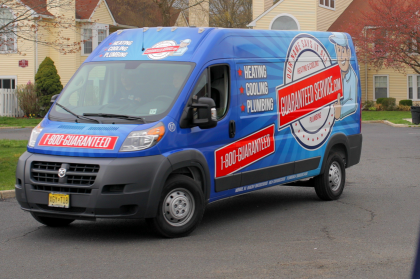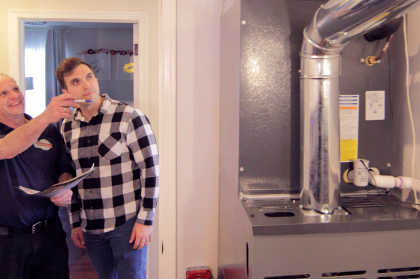Whole Home Humidifiers & Dehumidifiers for NJ
Dry winter air or sticky summer humidity can make your home uncomfortable and even unhealthy. A whole home humidifier or dehumidifier keeps the air balanced. This protects your family, your furniture, and your HVAC system.
At Guaranteed Service, we install and service whole-home systems. These systems add or remove moisture as needed. This helps keep your home’s humidity levels just right all year long.
Call Now:
Contact us today to get
$50 Off
Humidifiers and Dehumidifiers Service
HUMIDIFIERS & DEHUMIDIFIERS AT GUARANTEED SERVICE
Whole House Humidifier Installation
Living in New Jersey, you’ve likely noticed how humid the air can feel in the summer and how dry it becomes during the winter. What many homeowners don’t realize is that humidity levels can directly impact how efficiently your HVAC system performs and how comfortable your home feels year-round.
At Guaranteed Service, our New Jersey humidifier and dehumidifier experts can help you find the perfect balance for your indoor climate. A whole-home humidifier connects directly to your HVAC system, adding moisture to the warm air circulating through your home. Unlike portable units, these systems efficiently cover larger spaces and require little maintenance.
Our technicians will take the time to discuss your comfort preferences and recommend the right solution for your home whether that’s a bypass humidifier or a fan-powered unit. With the right equipment and expert installation, you can enjoy consistent comfort and better air quality in every season.
Whole-House Humidifiers & Dehumidifiers
Why You Might Need a Whole-House Humidifier
The combination of winter's dry air, a turned-up thermostat, and closed windows can wreak havoc on your respiratory system. The best way to combat dry air and reduce your susceptibility to infection is to invest in a humidifier. If you've suffered through too many colds, it might be time to see what all the hype is about. Some of the benefits of installing a whole-home humidifier include:
- They help relieve sinusitis : When the air is too dry, sinuses don't drain and function properly. According to many ENT experts, adding humidity to the air is generally good for sinus health-especially if you're regularly suffering from congestion and sinusitis.
- They help you heal faster : Whether it be a cold, asthma, or allergies, a humidifier keeps your nasal passages lubricated, which helps speed up the healing process when you're under the weather. For people with bad allergies, some humidifiers are specially designed to purify the air as well.
- They prevent nosebleeds : Another reason keeping your nasal passages moist and lubricated is essential is to prevent nosebleeds. If you're regularly experiencing them due to your dry climate, it's worth a try. Many people have found that it makes a huge difference.
- They alleviate snoring : The moisture from a humidifier keeps the throat from drying out and relieves the intensity of that annoying snoring sound. If you or your partner is a snorer, the bonus is that (at least) one of you will be sleeping more soundly. They support beautiful skin : Soothe dry skin by sleeping with a humidifier on through the night. In the morning, you'll notice not only that your face looks more supple but also that your hands and lips don't feel dry and dehydrated.
The Effects of Poor Humidity Levels
Hosts of health issues can plague you if your house or room isn't properly humidified during the heating season. Severely dry air with a humidity level below 30 percent can cause respiratory irritation, uncomfortably dry nasal passages, nosebleeds, and chapped and itchy skin. It can also exacerbate conditions such as allergies and asthma.
Dry air wicks moisture out of porous material such as wood, including hardwood floors, and can cause splitting and cracking. Your home and its contents can benefit from careful humidifying, especially wooden musical pieces such as pianos, violins, and cellos, as well as antique furniture, moldings, and other woodwork.
How Can You Reduce Humidity in Your Home?
If you have ever had a high level of humidity in your home, then you know how uncomfortable that can be. When the humidity level increases, it causes the air to become sticky and muggy. This will not only cause an uncomfortable feeling, but it can also cause problems in your home.
For example, high humidity can cause bacteria and mold to grow in your home. Mold and bacteria need one main ingredient to thrive, and that ingredient is moisture. Having a home with high humidity provides mold and bacteria with precisely what they need to survive. Follow these tips in order to help reduce the humidity in your home.
Shorten Your Shower Time
A simple reduction in the amount of time you spend in the shower can help reduce the moisture in your home. When you take long, hot showers the hot water produces a lot of steam. This steam can hang around on walls and other surfaces in your home. By taking shorter showers, you can reduce the amount of steam that is produced and thus decrease the humidity.
Proper Ventilation
An improperly ventilated home can cause an increase in the level of humidity. You could invest in a ventilator to help reduce the moisture in your home. And, if you already have a ventilator in your home, then you should make sure that it is functioning correctly.
Reduce The Number Of Plants
Having plants in your home can lead to an increase in the levels of humidity. Plants need a lot of moisture to survive. The soil of plants needs to be kept moist all the time. The moist soil that your plants are in can increase the production of bacteria and mold in your home. You do not have to remove all of your plants to decrease the humidity in your home, but keeping them to a minimum will help.
Dry Clothes Outside
When you use your dryer to dry your clothes, it produces water vapor. This is especially true if your dryer is not properly ventilated. By hanging your wet clothes on a clothesline to dry, you can decrease the amount of water vapor produced in your home.
Buy A Dehumidifier
Buying a dehumidifier for your home is probably the easiest way to reduce humidity. A dehumidifier gradually takes the moisture out of the air in your home. There is a tank in which this water accumulates. Once it is full, you simply remove the tank and pour out the water.
Different Types of Whole-House (Central) Humidifiers
Home Dehumidifiers
Summers in Central NJ can bring high humidity that makes homes feel sticky and uncomfortable. A whole home dehumidifier works with your HVAC system. It removes extra moisture from the air before it moves through your home.
This helps:
- Stop mold and mildew growth
- Protect walls, ceilings, and belongings from moisture damage
- Reduce musty odors
- Improve cooling efficiency during summer months
The Benefits of a Dehumidifier
There are several benefits to getting a dehumidifier in your home or workspace, which include:
- Keeps humidity levels in check for a more comfortable home
- Improves indoor air quality by limiting allergens like mold spores and dust mites
- Helps your cooling system run more efficiently, lowering energy costs
- Extends the life of your HVAC equipment by reducing strain
How a Humidifier Works
Whole home humidifiers connect to your HVAC system and add moisture as air passes through. The system uses a water panel or evaporative pad. It spreads water vapor into your ductwork. This helps balance humidity in every room.
This smooth design helps you keep your desired humidity. You won't need to refill tanks or move units like portable humidifiers.
Different Types of Whole-House (Central) Humidifiers
There are several types of humidifiers available, each designed for different home needs:
- Bypass Humidifiers: Simple, energy efficient, and cost-effective.
- Fan-Powered Humidifiers: More powerful for medium to large homes.
- Evaporative Humidifiers: Effective for homes with high square footage.
- Our experts can help you install a whole house humidifier. We will find one that fits your home and your family’s comfort needs.
Signs You Need a Dehumidifier
You may benefit from a whole home dehumidifier if you notice:
- Condensation on windows or water stains on ceilings – These are signs that excess moisture is trapped inside your home. Over time, this can lead to peeling paint, warped wood, or even structural damage. A whole-home dehumidifier helps control humidity before it causes costly repairs.
- Musty odors in basements or crawl spaces – Damp, enclosed areas are ideal environments for mold and mildew growth. If you detect a persistent musty smell, it’s a strong indicator that humidity levels are too high. A dehumidifier can help circulate dry, clean air throughout those problem areas.
- Mold growth in bathrooms or around vents – When humidity builds up, it often appears as black or green spots along walls, ceilings, or HVAC registers. This not only affects your home’s appearance but can also impact your indoor air quality. Reducing humidity helps prevent mold from returning.
- Sticky indoor air even when the AC is running – If your home still feels muggy despite running the air conditioner, the issue isn’t temperature — it’s moisture. A whole-home dehumidifier works alongside your HVAC system to remove excess humidity, making your home feel cooler, more comfortable, and more energy efficient.
Choosing a Dehumidifier
Choosing the right dehumidifier depends on your square feet, humidity levels, and HVAC system setup. Our technicians give expert advice on sizing. They recommend energy-efficient systems that keep your home comfortable without raising energy bills.
Our New Jersey dehumidifier experts can discuss your needs with you, measure humidity levels, and determine which unit will best suit your needs.
WHO WE ARE
At Guaranteed Service, We:

Promise not to mislead or offer any customer products or services that they do not need or want.

Promise to always be ethical and do the right thing, every time.

Promise to take personal responsibility for the satisfaction of every customer and will follow all company policies and procedures at all times.
Guaranteed Service
Our Location
2675 NJ-70 Manasquan, NJ 08736
Call Us:
Hours:
- Mon - Sun
- Open 24 Hours
Contact Our Team Today
Fast, Local Service
Contact Us
We will get back to you as soon as possible.
Please try again later.
SEE WHAT OUR CUSTOMERS ARE SAYING
TESTIMONIALS
★★★★★
Very thorough, answered all my questions.
Justin Ebner was the technician that came to my house when I had water leaking from the AC unit. He was courteous and took the time to walk me through the issue. He was very thorough, answered all my questions. I felt very comfortable that the issue was appropriately identified and the appropriate corrective action was taken.
-Suliman C.
★★★★★
Got an estimate in 1 day and install 2 days later. Everything was amazingly smooth and effortless and our new system is fantastic. Love our new thermostats too. We were very pleased, especially right now when people are having so many problems getting supplies and equipment. Already recommended to neighbors.
-Nancy Troske
★★★★★
Professional & Friendly
Truly great service! He was professional & friendly. He is clearly experienced because he installed a water-pressure sub pump backup system for us which is a complicated job. He came back again a couple of days later to replace an old leaking toilet. He was considerate with cleaning up afterwards too. I highly recommend Guaranteed Services & especially Rob.
-Steve Minarik
★★★★★
I Could Not Be Happier with the Service
I am so impressed! I had a water leak and the technician came out to fix my problem shortly afterwards. I could not of been happier with his service. Barry was polite, honest and extremely hard working. I truly appreciate all he did to help me on a bad situation.I highly recommend Guaranteed Services for all your needs. Thanks again!!
-Susan C.
★★★★★
Now we have a great system with a lifetime warranty.
These guys are the BEST. They replaced my old heating and air conditioning with energy star system. I love it. Quick and efficient. AL is a lovely young representative and he explained in detail what we getting. Brian, Tommy and Greg the installers, they worked very clean and they are wonderful. Now we have a great system with a lifetime warranty. Thank you GUARANTEED SERVICE.
-Kay G.
★★★★★
Very thorough, answered all my questions.
Justin Ebner was the technician that came to my house when I had water leaking from the AC unit. He was courteous and took the time to walk me through the issue. He was very thorough, answered all my questions. I felt very comfortable that the issue was appropriately identified and the appropriate corrective action was taken.
-Suliman C.
★★★★★
Got an estimate in 1 day and install 2 days later. Everything was amazingly smooth and effortless and our new system is fantastic. Love our new thermostats too. We were very pleased, especially right now when people are having so many problems getting supplies and equipment. Already recommended to neighbors.
-Nancy Troske
Humidifier & Dehumidifier FAQs
New Paragraph
What is the best whole house humidifier for my home?
It depends on your HVAC system and home size. We’ll recommend the best type based on your square footage and comfort needs.
How much does a whole house humidifier cost?
House humidifiers cost can vary depending on type and size, but we provide upfront pricing before installation begins.
Can you install a dehumidifier for crawl spaces?
Yes! We install crawl space dehumidifiers to control moisture in areas prone to mold and humidity.
What’s the difference between a portable and a whole home dehumidifier?
Portable units only work in one room. A whole home dehumidifier connects to your HVAC system. It helps balance humidity in the entire house.
Can a humidifier be repaired if it stops working?
Yes! In many cases, we can repair a whole home humidifier or replace key components to restore performance.

